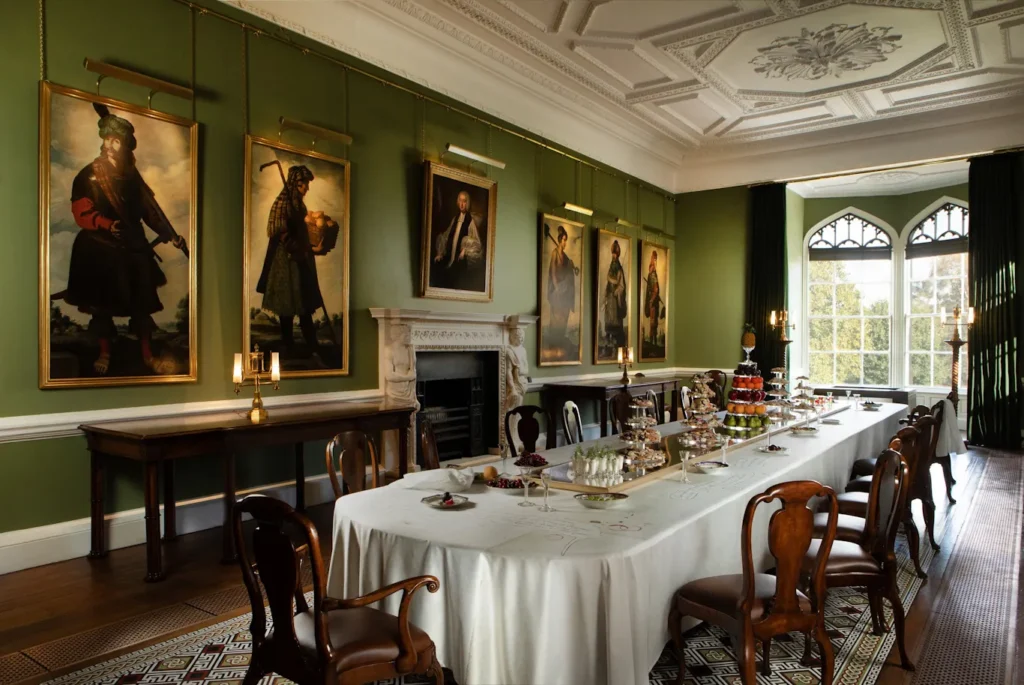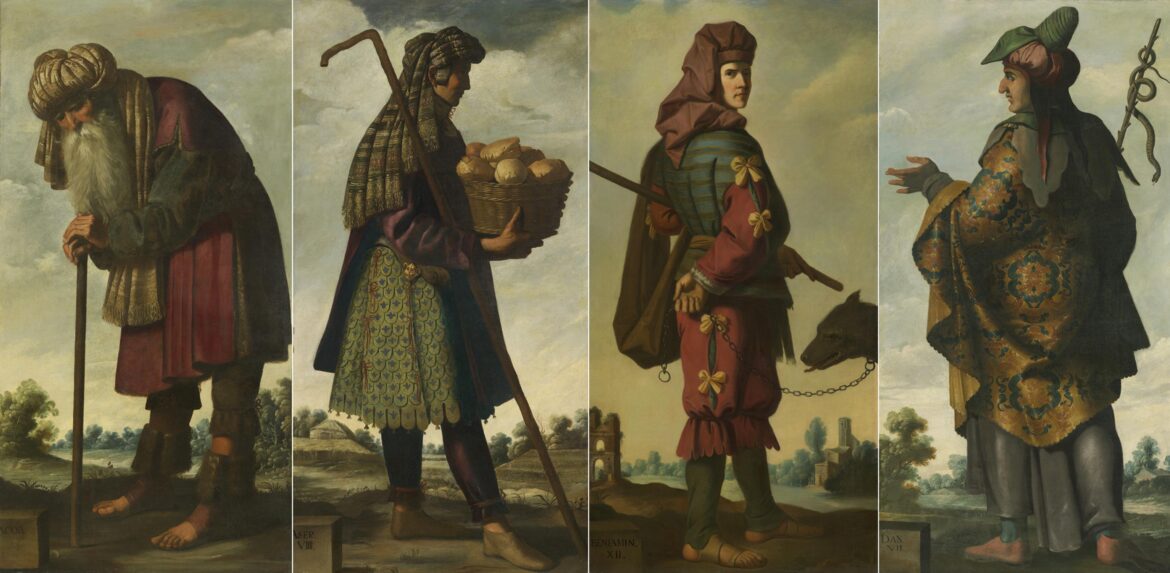Among the most celebrated achievements of 17th-century Spanish art is Francisco de Zurbarán’s series “Jacob and His Twelve Sons”, a striking collection of thirteen life-size paintings depicting the patriarch Jacob and his twelve sons from the Hebrew Bible. Created around 1640, this series exemplifies Zurbarán’s mastery of religious and portrait painting, his understanding of symbolism, and his unique ability to infuse monumental figures with human personality and dignity. Today, the series is regarded as one of Zurbarán’s most important works and a masterpiece of Baroque painting.

Francisco de Zurbarán: Life and Artistic Context
Francisco de Zurbarán (1598–1664) was a Spanish painter renowned for his religious works during the Spanish Golden Age. Born in Fuente de Cantos in Extremadura, he spent much of his career in Seville, a city that was one of the most vibrant cultural centers of 17th-century Spain.
Zurbarán became known as the “Spanish Caravaggio” because of his dramatic use of light and shadow, known as chiaroscuro, though his style was more meditative and serene than Caravaggio’s. He specialized in monastic and religious subjects, creating altarpieces and devotional paintings that combined spiritual intensity with realism.
By the time he painted Jacob and His Twelve Sons, Zurbarán was an established master with a reputation for combining pious sentiment, meticulous realism, and compositional clarity. The series exemplifies the artist’s ability to balance individual character with a cohesive thematic and visual structure.
The Series: Jacob and His Twelve Sons
The series consists of thirteen life-size paintings, each depicting Jacob or one of his sons: Reuben, Simeon, Levi, Judah, Dan, Naphtali, Gad, Asher, Issachar, Zebulun, Joseph, and Benjamin, along with Jacob himself. Each figure is portrayed standing alone against a plain, dark background, emphasizing the individual’s personality and status.
Composition and Style
Zurbarán’s approach in this series is remarkably restrained yet highly expressive. Each figure is:
- Life-size, lending the work a monumental presence.
- Standing alone, with minimal background distractions, which directs focus entirely on the figure.
- Attired in richly detailed garments, reflecting contemporary Spanish fashion rather than historically accurate biblical clothing. This anachronism was common in Baroque portraiture and allowed Zurbarán to imbue each figure with dignity and immediacy.
- Holding symbolic objects, which hint at the individual character or destiny of each son as described in the biblical narrative (Genesis 49).
The use of chiaroscuro gives the figures a sculptural quality. The light often falls from above or the side, creating a sense of solidity and volume. This dramatic illumination, combined with the dark backgrounds, enhances the spiritual and psychological intensity of each portrait.
Symbolism and Characterization
One of the most fascinating aspects of the series is Zurbarán’s ability to capture both individuality and typology. Each son is portrayed with symbolic attributes that reflect their biblical characterization:
- Reuben, the firstborn, may be depicted with elements suggesting instability or leadership potential.
- Joseph, often central in the arrangement, carries symbols of his prosperity or prophetic destiny.
- Judah, the ancestor of kings, might be represented with symbols of strength and authority.
These details not only affirm the biblical lineage but also allow viewers to reflect on the moral and spiritual qualities associated with each son. Zurbarán’s subtle gestures, facial expressions, and positioning convey personality, status, and inner life without overt dramatization.
Historical and Cultural Significance
The creation of Jacob and His Twelve Sons coincided with a period in Spain when religious imagery played a crucial role in cultural and political life. Commissioned by a private patron—likely Don Juan de Fonseca, an important figure in Seville—the series served both devotional and dynastic purposes.
- The biblical subject matter reinforced themes of family, inheritance, and divine providence, which were culturally significant in 17th-century Spain.
- The portraits functioned as both religious inspiration and a demonstration of social status, as patrons often commissioned biblical series to adorn private chapels or residences.
- By portraying the figures in contemporary attire, Zurbarán connected the biblical past to the present, making the stories relatable to contemporary viewers while preserving their sacred authority.
Technical Mastery
Zurbarán’s technique in the series demonstrates his command of oil painting, composition, and color:
- Brushwork: Precise and deliberate, especially in the rendering of fabrics, textures, and accessories.
- Color: Rich but restrained, with deep reds, blues, and golds that convey luxury and spiritual significance.
- Lighting: The use of chiaroscuro highlights facial features and folds in clothing, creating a sense of three-dimensionality.
Each painting, while standing alone, forms part of a cohesive visual ensemble, unified by scale, background, and approach to light. This balance between individuality and uniformity is a hallmark of Zurbarán’s genius.
The Series’ Journey Through Time
Originally commissioned for a private Spanish collection, the series has had a remarkable journey:
- In the 18th and 19th centuries, the paintings were dispersed across Europe and were held in various private and institutional collections.
- By the 20th century, the series was largely housed in the J. Paul Getty Museum in Los Angeles, where it became internationally recognized.
- Today, the Getty Museum has reunited all thirteen paintings, allowing scholars and visitors to appreciate the series in its entirety.
This movement and eventual reunification highlight the enduring significance of Zurbarán’s work, both as a historical artifact and as a masterpiece of Baroque art.
Reception and Legacy
Jacob and His Twelve Sons has long been admired for:
- Its monumental scale, which creates a dramatic and immersive experience.
- Psychological insight, as each figure exudes individuality and presence.
- Technical excellence, particularly in Zurbarán’s use of light, texture, and detail.
Art historians often cite this series as a pinnacle of Spanish Baroque portraiture, comparable in psychological depth and monumental impact to works by Velázquez and Ribera. The series has influenced both religious and secular portraiture, demonstrating how biblical subjects could be interpreted with contemporary relevance.
In modern times, the series continues to captivate audiences, appearing in exhibitions, art books, and scholarly studies. Its combination of spiritual, artistic, and cultural resonance ensures its place as a key work in the history of European art.
Viewing the Series Today
For contemporary audiences, viewing Jacob and His Twelve Sons is both a spiritual and aesthetic experience:
- The paintings are life-size, creating an almost theatrical presence that allows viewers to engage with each figure on a human scale.
- The arrangement—typically with Jacob central and the sons surrounding him—emphasizes hierarchy, lineage, and familial unity.
- Interpretive guides, catalogues, and museum labels provide historical context, biblical references, and artistic analysis, enhancing understanding and appreciation.
The series invites viewers to reflect not only on the biblical story but also on broader themes of family, legacy, morality, and divine guidance.
Conclusion
Francisco de Zurbarán’s Jacob and His Twelve Sons is more than a series of portraits; it is a masterful synthesis of religion, art, and human character. Each painting combines monumental scale, meticulous detail, and profound psychological insight, allowing viewers to engage with both the biblical narrative and the individual personalities of Jacob’s sons.
The series exemplifies the Baroque ideals of drama, clarity, and devotion, while also reflecting Zurbarán’s personal artistic genius. Its journey from 17th-century Spain to modern-day museums highlights its enduring significance as a cultural and artistic treasure.
For art enthusiasts, historians, and casual viewers alike, Jacob and His Twelve Sons offers a unique opportunity to witness how biblical narrative, artistic mastery, and human emotion can converge in a single, unforgettable body of work.

